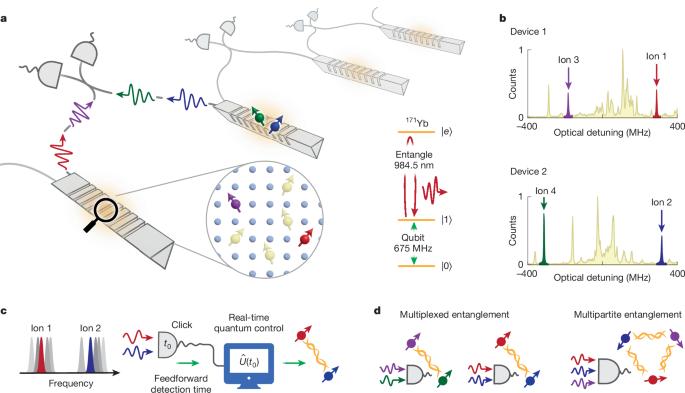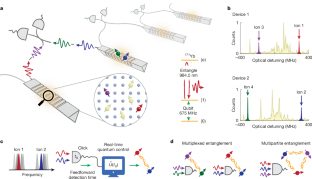Multiplexed entanglement of multi-emitter quantum network nodes
IF 48.5
1区 综合性期刊
Q1 MULTIDISCIPLINARY SCIENCES
引用次数: 0
Abstract
Quantum networks that distribute entanglement among remote nodes will unlock transformational technologies in quantum computing, communication and sensing1–4. However, state-of-the-art networks5–14 use only a single optically addressed qubit per node; this constrains both the quantum communication bandwidth and memory resources, greatly impeding scalability. Solid-state platforms15–24 provide a valuable resource for multiplexed quantum networking in which multiple spectrally distinguishable qubits can be hosted in nano-scale volumes. Here we harness this resource by implementing a two-node network consisting of several rare-earth ions coupled to nanophotonic cavities25–31. This is accomplished with a protocol that entangles distinguishable 171Yb ions through frequency-erasing photon detection combined with real-time quantum feedforward. This method is robust to slow optical frequency fluctuations occurring on timescales longer than a single entanglement attempt: a universal challenge amongst solid-state emitters. We demonstrate the enhanced functionality of these multi-emitter nodes in two ways. First, we mitigate the bottlenecks to the entanglement distribution rate through multiplexed entanglement of two remote ion pairs32,33. Second, we prepare multipartite W-states comprising three distinguishable ions as a resource for advanced quantum networking protocols34,35. These results lay the groundwork for scalable quantum networking based on rare-earth ions. Multiplexed entanglement distribution in a quantum network, with each node comprising multiple solid-state emitters in nanophotonic cavities, enables scalable quantum communication.


多发射器量子网络节点的多路纠缠
在远程节点之间分配纠缠的量子网络将开启量子计算、通信和传感领域的变革性技术。然而,最先进的网络5、6、7、8、9、10、11、12、13、14每个节点只使用一个光寻址量子比特;这限制了量子通信带宽和内存资源,极大地阻碍了可扩展性。固态平台15,16,17,18,19,20,21,22,23,24为多路复用量子网络提供了宝贵的资源,其中多个光谱可区分的量子比特可以托管在纳米级体积中。在这里,我们通过实现由几个稀土离子耦合到纳米光子腔25,26,27,28,29,30,31组成的双节点网络来利用这一资源。这是通过一种协议来完成的,该协议通过擦频光子探测结合实时量子前馈来纠缠可区分的171Yb离子。这种方法对于发生在比单次纠缠尝试更长的时间尺度上的慢光频率波动具有鲁棒性:这是固态发射器面临的普遍挑战。我们通过两种方式演示了这些多发射器节点的增强功能。首先,我们通过两个远程离子对的多路纠缠来缓解纠缠分布率的瓶颈[32,33]。其次,我们准备了包含三个可区分离子的多部w态,作为高级量子网络协议的资源34,35。这些结果为基于稀土离子的可扩展量子网络奠定了基础。
本文章由计算机程序翻译,如有差异,请以英文原文为准。
求助全文
约1分钟内获得全文
求助全文
来源期刊

Nature
综合性期刊-综合性期刊
CiteScore
90.00
自引率
1.20%
发文量
3652
审稿时长
3 months
期刊介绍:
Nature is a prestigious international journal that publishes peer-reviewed research in various scientific and technological fields. The selection of articles is based on criteria such as originality, importance, interdisciplinary relevance, timeliness, accessibility, elegance, and surprising conclusions. In addition to showcasing significant scientific advances, Nature delivers rapid, authoritative, insightful news, and interpretation of current and upcoming trends impacting science, scientists, and the broader public. The journal serves a dual purpose: firstly, to promptly share noteworthy scientific advances and foster discussions among scientists, and secondly, to ensure the swift dissemination of scientific results globally, emphasizing their significance for knowledge, culture, and daily life.
 求助内容:
求助内容: 应助结果提醒方式:
应助结果提醒方式:


